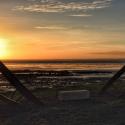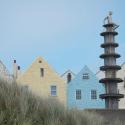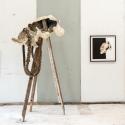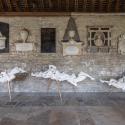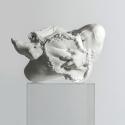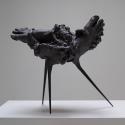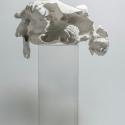Discipline
Figurative / Realism
Installation
Material
Brick/Concrete/Plaster
Bronze
Found Objects
Metal (other)
Mixed media
Other
Region
South West
Biography
Born in 1964, Anna Gillespie studied Philosophy, Politics & Economics at Wadham College, Oxford and then International Relations at the London School of Economics. In 1988 Anna returned to sculpture training in Stone Masonry and Carving before working at Centro d'Arte, Verrocchio, Italy as studio assistant to sculptor Nigel Konstam. Anna then completed an MA in Fine and Media Arts. She now lives and works in the South West of England and is represented by the Beaux Arts galleries in Bath and London. Anna Gillespie has work is in the collections of The Prudential, Burghley House Sculpture Park, The Somerset Museum, Museo Arte Contemporanea Sicilia, Bodrum Sculpture Park Turkey and also in private collections throughout America, the Middle East, and Europe.
Recent visits to Africa and America have shifted Gillespie’s focus from the natural environment near her home to the way in which humans are influenced by the man-made environment and our interaction as a species with the planet. This new work, whilst it may appear to draw on current events, seeks to draw parallels with the historical experience of people and their movements across the surface of the Earth through the ages.
In the work created from locally found organic tree material the individual was subsumed by the experience of melding with nature – all of us fundamentally the same and yet no two alike. In the new works the individual is lost within the built environment, individuality being almost unrecognisable within the mass of humanity that we now face ourselves being part of. Despite these political aspects to Gillespie’s work, one senses that the figures she creates are also deeply personal.
Anna is now exploring biomorphic plaster forms, playing along the spectrum between abstraction and the intense replication of detail that life casting allows.
Ironically perhaps, part of this desire to capture felt experience rather than observed appearance, seems to involve the ‘accuracy’ of representation and detail that body casting allows. The lived experience of wrinkles and pores, creases and rolls, tissue and joints is captured in fascinating detail by alginate and then the resulting white plaster casts, or transmuted once again through machine-like graphite grey. The ‘classical’ result is somehow pleasingly at odds with the brutal reality of our imperfect bodies, especially as they age. This unforgiving imprint is essential to the felt experience of being in a body and the inescapability of our fundamental embodied and limited existence as humans.
In some senses here I am working towards an environmental statement. We live in our limited bodies as we live on this finite planet and, despite our illusions, cannot escape into a purely limitless, digital world in which we can extract from at will and yet still hope to survive.
In the casts I am drawn to ‘mistakes’ as much as ‘perfection’, as I am in our human bodily existence. In a digital age of airbrushed images I hope to draw attention to unusual beauty, vulnerability and strength of the reality of our working bodies. I also enjoy the physicality of working in the studio – particularly at the moment with plaster – a traditional and humble material whose cheapness allows for experimentation and absorbs me totally as I work.
